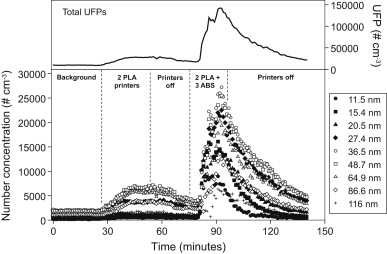
A new report has examined the propensity of personal 3D printers to emit ultrafine particles. “Ultrafine Particle Emissions from Desktop 3D Printers” by Brent Stephens, Parham Azimia, Zeineb El Orcha and Tiffanie Ramosa of the Department of Civil, Architectural and Environmental Engineering, Illinois Institute of Technology, Chicago and the National Institute of Applied Sciences in Lyon says:
The desktop 3D printers measured herein can all be classified as “high emitters” with UFP emission rates greater than 1010 particles per min.
This is in line with our suspicions. We’ve often observed odors and aromas when 3D printers are in operation and suspected these vapors could contain harmful material. While the report does not specify possible effects of the airborne UFPs, one can imagine it is not helpful if the surface of your lungs is covered with UFPs made of artificial materials.
Ironically, the fascination with 3D printers has increased the probability of this effect. Many people are mesmerized by the visible act of 3D printing; they want to see it print. Accordingly, many manufacturers have specifically designed their devices to be open, permitting wide views of print action. However, this also permits UFPs to escape en masse.
How bad is it? The report says:
For comparison, our estimate of the total UFP emission rate for a single PLA-based 3D printer was similar to that reported during cooking with an electric frying pan.
ABS printing was much worse, with perhaps 10x as many particles emitted, probably due to the higher melting temperature.
What’s the answer here? Ventilation. We strongly recommend, as we have done in the past, to always operate your personal 3D printer in a very well ventilated area. If you can smell it, there’s something wrong. For a deeper dive, you might want to check out Joris Peels’ analysis at the link below.
There’s one more solution: manufacturers of personal devices could include air flow and filtration within the unit. This would likely disappoint those wanting a great view of a print, but on the other hand you won’t die.
Is there a market for a standalone vacuum filter that one could attach to existing personal 3D printers? We think so.
Via Science Direct and VoxelFab (Hat tip to Andrew)

